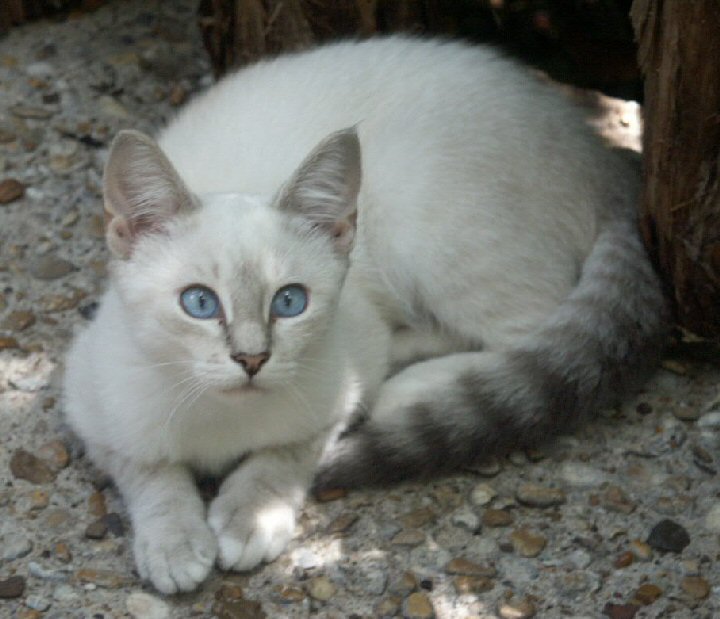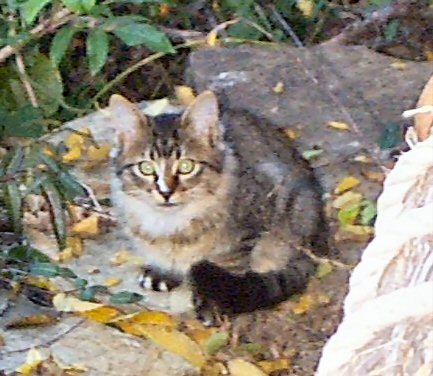
Physical Description:
Size of domestic cats varies less than that of domestic dogs, but body
length ranges from 19 to 29 inches and weight from 5 to 20 pounds. Their
hair is soft and may be either long or short. The "wild type"
coat pattern is tabby, with dark markings over a base color of orange,
tan or gray, but human breeding has produced many other coat patterns.
Social Organization::
All cats except for lions are solitary, except when they pair briefly
for mating. However, in domestic situations, cats may tolerate one another,
mutually groom, play and sleep together. This may relate to the ready
availability of food, as wild and feral cats maintain large hunting territories.
Feral cats may also form colonies around garbage dumps or other good food
sources.
General Information and
Adaptations:
The domestic cat lineage, which includes both African and European wild cats as well as domestic cats, is thought to have arisen 8 to 10 million years ago within the cat branch of the Carnivores. (The "big cat" group that includes lions, leopards, jaguars and tigers is younger, appearing 4-6 million years ago.)
The closest genetic relative of modern domestic cats is the African wild cat (Felis sylvestris libyca). African wild cats resemble domestic tabbies. Domestic cats were first documented 3-4000 years ago in Egypt, where they may have been attracted to human agricultural settlements by the ready supply of rodents gathered around stored grains and other crops. They have thus been partnered with humans much more recently than domestic dogs, which may date back as far as 100,000 years.
Domestic cats have excellent sight, a keen sense of smell and sharp hearing. The eyes have a reflective layer in the retina, which enhances their night vision, and the pupils are vertical, typical of nocturnal animals. They can hear sounds up to about 65 kHz, well above the limit of human hearing.
They are fast and agile, can jump many times their body length and are excellent climbers. Both teeth and claws are adapted for hunting. Long sharp canines and knife-edged cheek teeth make them formidable predators. The claws are retractable, and cats mark territory by clawing trees (or furniture),
Reproductive Behavior:
Female cats go through estrus several times a year. Both domestic and
feral cats engage in a vociferous courtship and mating, after which the
male and female separate. Gestation is 8-9 weeks, and 1-8 (typically 4)
kittens may be produced. The kittens have hair, but their eyes open after
1-2 weeks, at which time they also begin to walk. They are weaned at about
10 weeks, can fend for themselves by about 6 months, and reach sexual
maturity at about 10 months. Kittens remain with their mothers until adulthood.
The Animal at the Zoo:
The feral cat in the photo at the top of the page was photographed
at the zoo, where it was hanging hopefully around the snack bar. Above,
the same cat was seen checking out the food in the Aldabran tortoise exhibit. The
kitten below was seen under one of the visitor walkways. Feral cats are
attracted to the zoo, where they can scrounge a few scraps both from food
dishes in open exhibits and from humans in the various food courts.

Page Author:
M. A. Clark
mac@whozoo.org
Sources and Links:
- The Backyard Predator:
http://www.felinefuture.com/nutrition/bpo_ch0.php - Wildlife on Easy Street:
http://www.wildlifeeasyst.com/domestic_cats.htm - Lioncrusher's Domain:
http://www.lioncrusher.com/animal.asp?animal=72 - University of Michigan Animal Diversity Web:
http://animaldiversity.ummz.umich.edu/accounts/felis/
f._silvestris_libyca$narrative.html